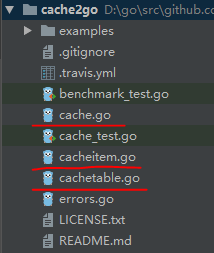一、cache2go是什么
二、项目结构

项目目录结构如上图所示,可以看到功能实现相关源码文件只有3个:
- cache.go
- cacheitem.go
- cachetable.go
三、关键数据结构
项目中只涉及到2个复杂的数据类型,分别是:
- CacheItem
- CacheTable
含义和字面意义一致,一个是缓存表,一个是缓存表中的条目。下面分别看一下这2个结构是怎么定义的。
1、CacheItem
CacheItem类型是用来表示一个单独的缓存条目,源码如下所示,每个字段都很清晰易懂,注释稍长的属性已经中文标注。
type CacheItem struct {
sync.RWMutex
// The item's key.
key interface{}
// The item's data.
data interface{}
// How long will the item live in the cache when not being accessed/kept alive.【不被访问后存活时间】
lifeSpan time.Duration
// Creation timestamp.
createdOn time.Time
// Last access timestamp.
accessedOn time.Time
// How often the item was accessed.
accessCount int64
// Callback method triggered right before removing the item from the cache【被删除时触发的回调方法】
aboutToExpire func(key interface{})
}
2、CacheTable
CacheTable描述了缓存中的一个表项,里面的items属性就是上面讲到的CacheItem类型实例。这里除了常规属性外还有若干函数类型的属性,源码如下所示:
type CacheTable struct {
sync.RWMutex
// The table's name.
name string
// All cached items.【一个表中的所有条目都存在这个map里,map的key是任意类型,值是CacheItem指针类型】
items map[interface{}]*CacheItem
// Timer responsible for triggering cleanup.【负责触发清除操作的计时器】
cleanupTimer *time.Timer
// Current timer duration.【清除操作触发的时间间隔】
cleanupInterval time.Duration
// The logger used for this table.
logger *log.Logger
// Callback method triggered when trying to load a non-existing key.【需要提取一个不存在的key时触发的回调函数】
loadData func(key interface{}, args ...interface{}) *CacheItem
// Callback method triggered when adding a new item to the cache.【增加一个缓存条目时触发的回调函数】
addedItem func(item *CacheItem)
// Callback method triggered before deleting an item from the cache.【删除前触发的回调函数】
aboutToDeleteItem func(item *CacheItem)
}
如上所示,cache2go的核心数据结构很简洁,应该比较容易理解。当然没有完全理解每个字段这样定义的原因也别急,看完下面的代码逻辑后反过来再看数据结构,肯定就明白每个字段的作用了。
四、代码逻辑